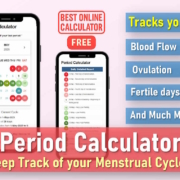Age Calculator: Find Your Exact Age in Years, Months, and Days
This free chronological age calculator determines your current age based on the date you enter in the ‘Date of Birth’ field. You can also choose a specific date in the ‘Age at the Date’ field to find out how old you were on that day. The result will show your age in years, months, days, hours, minutes, and seconds.
What Is an Age Calculator?
A chronological age calculator is a simple tool that calculates your age based on your birth date. Unlike manual calculations, it eliminates errors and provides instant results in multiple formats, years, months, days, and even seconds. This tool isn’t just for personal use; you can also use this to calculate the age of pets, objects, or historical events.
How to Use the Age Calculator
Our test age calculator is designed for ease of use. Follow these steps:
- The calculator defaults to today’s date in the “Age at the Date” field and sets “Date of Birth” to 20 years prior.
- To find your current age, enter your birth date in the “Date of Birth” field.
- For past or future dates, input your birth date and the target date in the “Age at the Date” field.
- Adjust the year or month easily using the calendar controls.
- Click “Calculate” to see your results.
- Use the “Reset” button to clear all fields and start fresh.
Reading Your Results
Once you hit “Calculate,” the age in months calculator provides a detailed breakdown:
- Primary Result: Your age in years, months, and days (e.g., “25 years, 6 months, 12 days”).
- Additional Details: For deeper insights, see your age in weeks, total days, or even hours, minutes, and seconds.
How the Age Calculator Works
Our free chronological age calculator uses the Gregorian calendar—the standard system worldwide—to deliver precise results. Here’s how it breaks down:
- Gregorian Calendar Basics: A typical year has 365 days, while leap years (like 2024) have 366. Months vary in length: January, March, May, July, August, October, and December have 31 days; April, June, September, and November have 30; and February has 28 (or 29 in leap years).
- Age Calculation Logic: The tool counts full years first, then remaining months and days. For example, you turn “1 year old” after completing 12 full months from your birth date. This ensures accuracy for uses like a chronological age calculator in months or Pearson age calculator for assessments.
Beyond Birthdays: Creative Uses for the Age Calculator
This tool isn’t just for personal milestones, it’s versatile enough for pets, history, and planning. Here’s how:
1. Chronological Age for Official Needs
Schools, doctors, and government agencies often require exact age verification. A chronological age calculator provides this in years, months, and days, critical for medical records, school enrollments, or legal documents.
2. Track Infant Development
Parents and pediatricians rely on tools like an infant age calculator or how old is my baby calculator to monitor growth. By displaying age in weeks and days (e.g., “14 weeks, 3 days”), it helps schedule vaccinations and track milestones like crawling or first words.
3. Pet Age Conversion
Ever wondered how old your dog is in “human years”? While breed-specific formulas exist, a basic puppy age calculator in weeks helps manage early-stage care. For example, a 12-week-old puppy might need different food than a 6-month-old.
4. Relive (or Plan) Special Moments
Curious how old you were on graduation day? Or how old you’ll be at a future anniversary? Input any date to find out—ideal for nostalgia or planning with an anniversary calculator approach.
5. Historical and Educational Tool
Teachers and history buffs can calculate the age of landmarks or events. For instance, input the completion date of the Statue of Liberty (October 28, 1886) to see it’s been [calculated years] years old, a great classroom activity!










